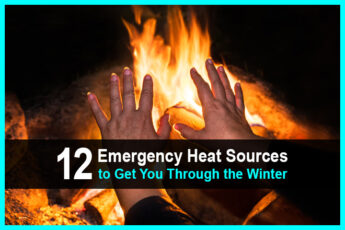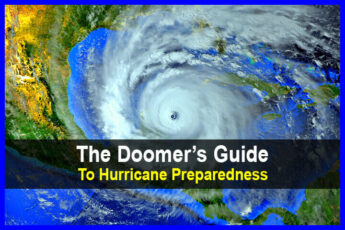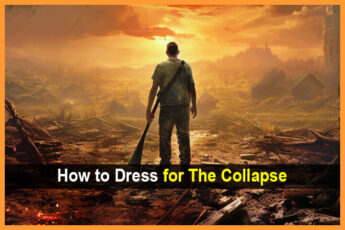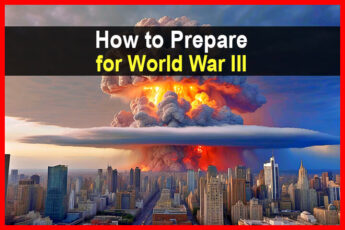Estimated reading time: 11 minutes
In many parts of the country, blizzards are relatively rare events. A blizzard is defined as a combination of heavy snow, low temperatures creating “powder” snow and wind speeds in excess of 35 mph. The combination not only results in heavy snowfall accumulations but the cold temperatures and high winds cause the snow to continually fill the air.
A worst case scenario in any blizzard is a white out. That’s when the falling snow and the snow on the ground is stirred up by the wind making it impossible to tell the ground from the horizon. It’s particularly threatening for anyone driving or walking outside.
Want to save this post for later? Click Here to Pin It On Pinterest!
An Alarming Statistic
Blizzard events are actually increasing in frequency and severity around the world. This is happening in spite of the fact that climate change has resulted in higher average temperatures and shorter winters. The reason is that the higher temperatures of both the air and the oceans is causing higher saturations of moisture to reach the atmosphere.
When cold temperatures meet the high moisture saturation the result is a blizzard condition. This can get extreme as polar vortex’s continue to emerge bringing cold Arctic air to lower latitudes. The results are snow events that used to happen once a decade occurring with greater frequency.
China recently was struck by a midday blizzard the caused the death of ___ people as pedestrians and traffic were caught by surprise with the intensity of the event.
Anchorage, Alaska is no stranger to snow but a recent blizzard dropped 2 feet of snow in less than a day and cause massive power outages.
And then there’s the blizzards that struck the U.S. east coast resulting in names like “Snowpocalypse” and “Snowzilla.” And in 2022 Buffalo, New York was struck by a blizzard that left 20,000 people without power and 28 dead.
Primary Threats from a Blizzard
The threat from a blizzard is proportional to your location and exposure to the event. In that regard it’s not much different than other natural disasters but blizzards pose some unique threats.
- Wind chill factors are often extreme in a blizzard. Any combination of 35+ mph winds and cold temperatures will create dangerous wind chills. A 35 mph wind and a temperature of 30 degrees creates a wind chill factor of 14º Fahrenheit.
- White out conditions literally blind you in a blizzard. This is not only a hazard for anyone driving but many people have found it impossible to find their way while walking during a whiteout. This could lead you to walking into traffic, or simply fail to find your way to safety even on your own property.
- Prolonged exposure to snow in the air and on the ground will eventually cause your body heat to melt the snow leaving you wet in high wind chills. Hypothermia quickly follows leading to severe frostbite and even a heart attack or just plain freezing to death.
- Power outages are common during a blizzard mostly due to the high winds and the severe wind chills create a threat even in the relative safety of your home.
- Lack of emergency services is another factor in a blizzard. Local police, fire departments and ambulances are often overwhelmed and have to struggle with the same blizzard conditions affecting everyone else.
- Getting stranded is a common occurrence as roads become impassable. People trying to get to or from work; kids at school, anyone outside for any reason and some distance from home can find themselves in a survival situation in a blizzard.
3 Blizzard Survival Situations
This is true for any disaster and affects people the same way during a blizzard. It’s all about location. Here are the 3 blizzard survival situations anyone could confront:
- Surviving a Blizzard at Home
- Surviving a Blizzard in Your Vehicle
- Surviving a Blizzard on Foot
All 3 present unique challenges and without some level of planning and preparation can result in tragic outcomes.
1. Surviving a Blizzard at Home
A common sense recommendation is that anytime a blizzard is predicted it’s best to stay home. Unlike manmade disasters that can strike without warning, most natural disasters like blizzards have a fair amount of warning.
But just because you know it’s coming doesn’t make everything safe. This is especially true if a power outage occurs. Any winter power outage is a threat but if it’s just about cold temperatures we can always shut off the water and hop in the car to stay warm with a friend or relative with power.
Blizzards make the quick bug out to a friend’s warm home or a local warming shelter a bad idea. In that regard you and your family are both stranded and trapped in a house without heat.
Anyone with a fireplace and some amount of firewood has a fighting chance but there are other options worth considering to supplement a fireplace or for those without a fireplace.
- A wood burning stove
- A propane heater
- A kerosene heater
- A generator to power an electric space heater or electric blankets
- Improvised heaters using candles, alcohol and even Crisco to create heat
- Layered clothing and blankets, blankets, blankets
Any heating solution that involves burning any kind of fuel should be vented. You often read that a window or door should be left open for “proper” ventilation, but who opens a door or window in a raging blizzard.
It’s better to have a small chimney or pipe to vent those fumes. Here are some articles about how to stay warm at home in winter during a power outage with detail in depth on these ideas:
- 10 Steps To Surviving A Winter Power Outage
- 6 Things To Do Before a Winter Storm Strikes
- 17 Ways To Stay Warm If The Power Goes Out
- How to Prepare for a Dark Winter
- How to Prepare Your Home for a Brutal Winter
- 15 Ways To Stay Warm When The Power Is Out
- 21 Winter Survival Items Every Prepper Should Own
- 3 Safest Ways to Heat Your Home in an Emergency
2. Surviving a Blizzard in Your Vehicle
This may be the most likely scenario for people who find themselves confronted with the threat of a blizzard. The kids usually enjoy one of those rare and enjoyed “snow days” and get to spend the day at home, but for many of us we’re expected to be at work. And it’s often while we’re at work that the snow that was predicted emerges as a full blown blizzard.
Another scenario is whenever someone is travelling any distance for business or to visit a distant location or family member. While on the road we drive into a blizzard without fully expecting how difficult and demanding the conditions will be.
Either way, getting stranded in a blizzard in your vehicle will present a whole new set of challenges. The good news is that a vehicle affords you some level of protection from the wind and the snow. The bad news is that you may be there for a while and even overnight.
Here are some of the recommendations for surviving a blizzard when trapped in your vehicle.
- Don’t abandon the vehicle. Unless you can clearly see a path and destination to safety, stay in your vehicle. It’s tempting to think you can walk to safety but a few moments in the wind and cold should give you pause.
- Use the heater in your vehicle to stay warm but the standard recommendation is that you only run the vehicle for 10 minutes each hour. You want to conserve your gas and intermittent heating will keep you from freezing. And while you’re at it, always activate your emergency flashers when you are running the engine. It will at least give others fair warning if they don’t see your parked car during the blizzard.
- Clear the tail pipe of any accumulated snow whenever you run the engine while idling. Snow can accumulate around the tail pipe and cause carbon monoxide to backup into the vehicle. That’s bad.
- Plan ahead and make sure you have some basic gear in your trunk in winter. This would include blankets, flashlight, some water and snacks and even pocket hand warmers and maybe an extra hat or two.
- Call home or someone to let them know what you’re situation is. You don’t want to encourage a family member to try and find you in a blizzard but let them know what’s going on. You should also call 911 and even though you won’t be the only one doing so, they’ll at least have a record of who and where you are.
- Stay hydrated. Cold weather can dehydrate you faster than a hot day. If you don’t have any water you could always try melting some snow. There will no shortage of that resource.
Here are some links to articles that offer some very good advice about other considerations and more detail about surviving in a car in winter:
- How to Stay Warm in Your Car When Stuck During A Winter Storm
- 27 Winter Survival Items To Keep In Your Car
- How I Stay Warm In My RV When It’s FREEZING Outside
- What To Do If You’re Trapped In Your Car
- How to Store Emergency Water in Your Car
- 15 First Aid Items to Keep In Your Vehicle
- 21 Things You Should Have In Your Vehicle At All Times
- 17 Emergency Foods You Should Keep in Your Vehicle
3. Surviving a Blizzard on Foot
This is the worst case scenario. Your home or your vehicle will at least give you some protection from the wind and snow, but outdoors your options are limited. One of the obvious solutions is to find shelter. Knock on a door, find an open business, even an abandoned building can be a safe port in a storm.
Then again, whiteout conditions can make it impossible to see any refuge especially if it’s at a distance. Wandering in a blizzard looking for shelter is not a best case scenario. Even if you have to huddle next to a tree or improvise a shelter, anything’s better than full exposure to the wind… at least for a while.
A troubling statistic is how many people die in a blizzard in their backyards, neighborhoods or on their farms. The psychology is that we feel so close to home that we can eventually find it. During a white out it may be impossible to find anything, and all of those familiar landmarks that we don’t even think about are suddenly out of sight.
In a wilderness environment we would probably hunker down quickly and try to build a shelter, maybe a fire and wrap up as much as possible to stay warm and wait it out. Few take those steps when they feel the comfort of their home is so close if only they could see it.
Here are some common recommendations for surviving a blizzard on foot.
- Get out of the wind and snow. Unless you can see where you’re going and it’s not too distant, find some kind of shelter. The storm will eventually subside and with any luck you can at least stay sheltered until it does.
- Call somebody. If you have a cell phone call 911. Don’t assume emergency services won’t try to find you. If you’re close to home, call home. If you simply can’t see where you’re going someone could beep a car horn, call your name, flash exterior house lights off and on or even start a bonfire in the backyard to hopefully cut through the snow and indicate a destination and direction to travel.
- Make a shelter especially if you’re in a wilderness situation or in a very remote area. There are natural shelters like low-growing pine trees, large tree trunks, even hills, cliffs and the occasional cave may be all you need to get through the worst of it. If you can, try to assemble some branches to build a makeshift lean to or anything else you can improvise to get out of the wind.
There are many scenarios that could find you on foot in a blizzard. Here are links to some articles that cover some of the situations and ways to survive on foot in blizzard:
- How to Survive If You’re Stranded in the Winter Wilderness
- 10 Winter Camping Tips So You Don’t Freeze
- Quick Trick to Keep Your Feet Warm in Freezing Weather
- 6 Tips To Help You Survive a Blizzard
- How to Build a Fire in the Snow
- 3 Easy Survival Shelters Even Beginner’s Can Make
- 8 Easy Tarp Shelters for Survival
The Odds are Increasing
It used to be that we thought of winter storms and blizzards as events that happened when we were kids as an on odd and unexpected experience. Given the rate of climate change and the new factors driving our weather it may become more than a memory.
Complicating matters going into this winter is a Super El Nino event that will bring more snowfall to many parts of North America. Some of us prepare for a lot of things but don’t get around to all of them. Maybe this winter is a good time to move preparations for a blizzard up on the priority list.
Like this post? Don't Forget to Pin It On Pinterest!








